At least 22 women have died after taking the abortion pill regimen, RU-486, and many others have experienced serious complications, according to updated data from the Food and Drug Administration (FDA). While abortion — and specifically, medication abortion — is sold to women as “safe,” there can be serious and life threatening complications from the abortion pill, as noted by the pills’ manufacturer, Danco. Although Danco is required to report any death associated with Mifeprex, women experiencing complications, various factors — such as not returning to the abortion provider or not reporting use of the drug to emergency personnel — may cause these numbers to seem lower than they actually are.
The abortion lobby is pushing for easy access to the abortion pill on college campuses and some are even calling for it to be approved for home use. No doubt, we may never know how many women suffer serious complications or succumb to death from the abortion pill if this happens. Clearly, according to its manufacturer, there are serious risks:
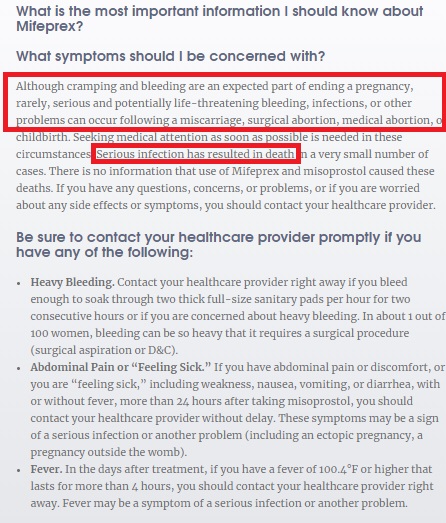
RU486 abortion pill serious complications (Image credit: DANCO)
The abortion inducing regimen is made up of two pills, Mifeprex (mifepristone) and misoprostol, which, according to the FDA, will end “an early pregnancy (70 days or less since the first day of the last menstrual period).” Of course, “the pregnancy” is a term for ending the life of a preborn child in the womb. But, sometimes these chemicals also claim the lives of their mothers. The abortion is explained by Dr. Anthony Levatino in the video below:
Monte Patterson, the father of Holly Patterson, attempted to convey the dangers of the abortion pill before a House committee in 2006, when far fewer women had died. Holding a picture of his daughter, Monte described to that committee the tragic way Holly died after being given the drug at Planned Parenthood.

Monte Patterson holds up pic of daughter dead after taking RU486 at Planned Parenthood (Image credit: CSPAN)
“I wanted to show you a picture of my daughter so at least you see what I have lost… Holly, who died at 18, and the other women who have died or have been seriously hurt by taking the RU-486 medical abortion drug regimen as a solution to their unplanned pregnancy, ” Mr. Patterson said.
He told the committee:
Twelve days after Holly’s 18th birthday, on September 10, 2003, she walked into a Planned Parenthood clinic to be administered an RU-486 medical abortion regimen. By the 4th day, she was admitted to the emergency room…. She complained of bleeding, cramping, constipation, and pain, but subsequently, she was sent home. Seven days after taking RU-486, Holly returned to the same emergency room hospital complaining of weakness, vomiting, abdominal pain.
Hours later, I was called to the hospital, where I found her surrounded by doctors and nurses, barely conscious and struggling to breathe. Holly was so weak she could barely hold onto my hand…. I watched Holly succumb to a massive bacterial infection as a result of a drug-induced abortion with RU-486….
In 2005, the journal Contraception published a letter from Dr. Philip Darney, who claimed the death rate from medication abortion among Planned Parenthood patients, at that time, was “1.5 per 100,000 compared to a US rate of .5 for early surgical abortion.” Darney is no pro-lifer, and has served on the boards of Planned Parenthood Federation of America and the Guttmacher Institute, Planned Parenthood’s former research arm.
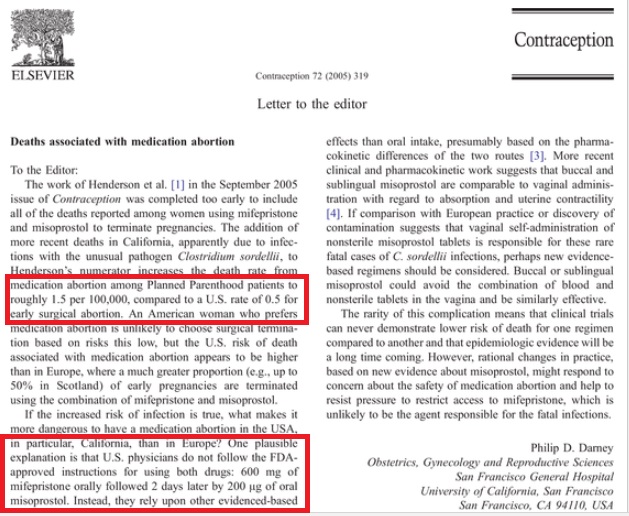
Philip D Darney on abortion pill deaths Planned Parenthood and evidence based protocols (Image credit: Journal Contraception)
In his letter, Darney pointed out that the US death rate using the abortion pill was higher than in Europe, possibly because, in the states, “US Physicians do not follow the FDA approves instructions for using both drugs…. Instead, they rely on evidence based protocols….”
Currently, according to the FDA, as of December 31, 2017, there have been reports of 22 deaths associated with the abortion pill regimen and several cases of severe systemic infection (also called sepsis), including some that were fatal.
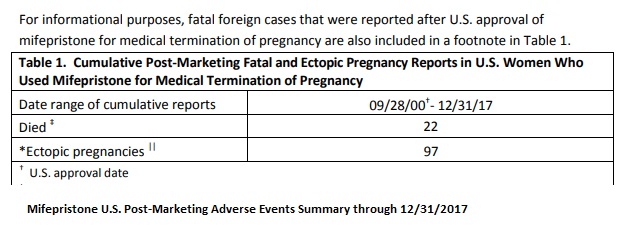
RU486 abortion pill deaths updated 2017
In addition to deaths, between 2000 and 2012, numerous serious complications were also reported:
- Cases with any adverse event – 2740 (average 228/yr)
- Hospitalized, excluding deaths – 768 (average 64/yr)
- Experienced blood loss requiring transfusions – 416 (average 35/yr)
- Infections – 308 (average 26/yr)
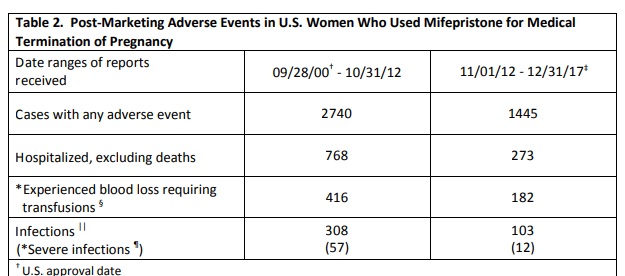
RU486 abortion pill serious adverse effects updated 2017
Within the past five years (between 2012 and 2017) complication reports from the abortion pill have remained steady:
- Cases with any adverse event – 1445 (average 289/yr)
- Hospitalized, excluding deaths – 273 (average 55/yr)
- Experienced blood loss requiring transfusions – 182 (average 36/yr)
- Infections – 103 (average 21/yr)
In one state alone — Ohio — complications from the abortion pill have increased an astronomical 87 percent since 2014.
Planned Parenthood and the abortion industry present abortion as “safe and simple,” but one look at forms they require women to sign reveals the real truth. Missed abortion, blood clots, infection and even death are among the risks associated with medication abortion.
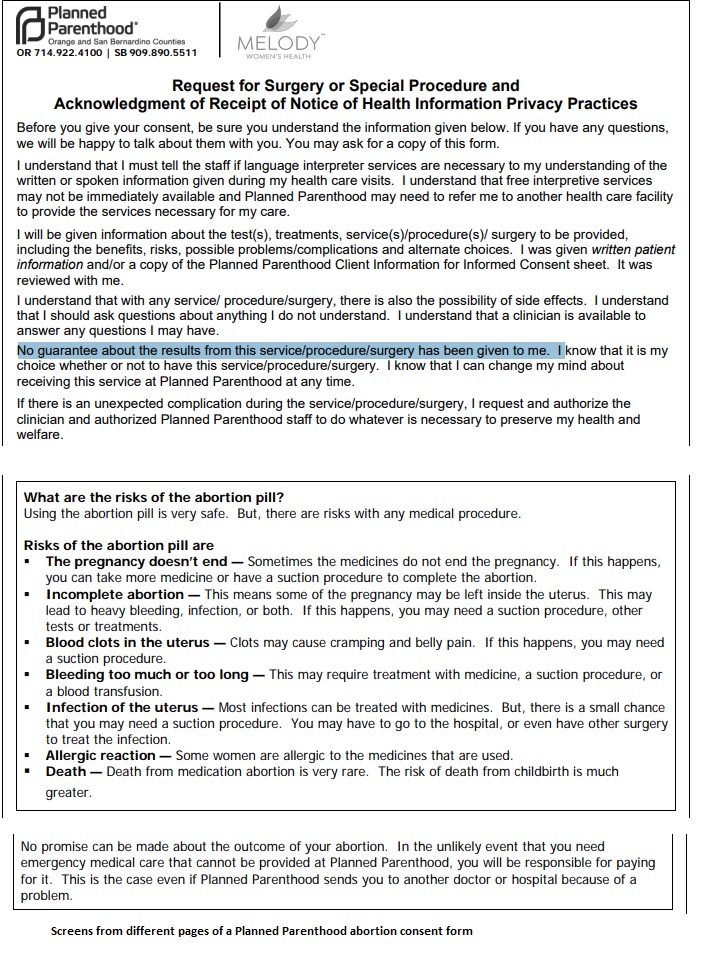
Planned Parenthood abortion consent form
Editor’s Note: FDA has received reports of serious adverse events in women who took mifepristone. As of June 30, 2021, there were reports of 26 deaths of women associated with mifepristone since the product was approved in September 2000, including two cases of ectopic pregnancy (a pregnancy located outside the womb, such as in the fallopian tubes) resulting in death; and several cases of severe systemic infection (also called sepsis), including some that were fatal. The adverse events cannot with certainty be causally attributed to mifepristone because of concurrent use of other drugs, other medical or surgical treatments, co-existing medical conditions, and information gaps about patient health status and clinical management of the patient. A summary report of adverse events that reflects data through June 30, 2021 is here.







